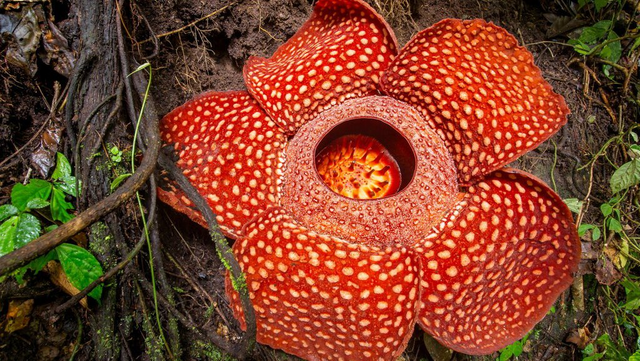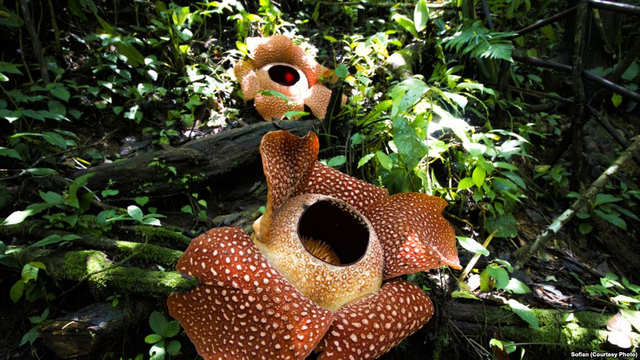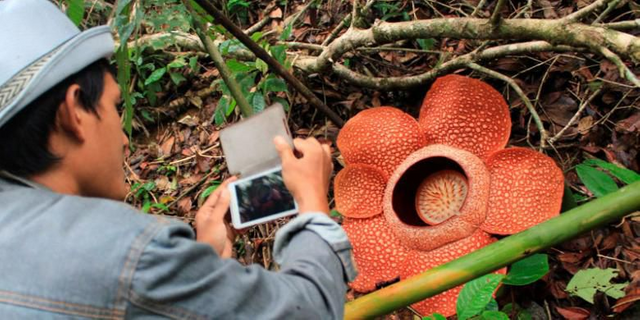Rafflesia Arnoldi Flower
Rafflesia Arnoldi flower is a mandatory parasite plant that is famous for having very large flowers, even the largest flower in the world. It grows in the plant tissue vine (liana) Tetrastigma and has no leaves so it is not able to photosynthesize. The naming of this gigantic flower cannot be separated by the history of its discovery first in 1818 in the tropical forests of Bengkulu (Sumatra) somewhere near the Manna River, Lubuk Tapi, South Bengkulu Regency, so Bengkulu is known in the world as The Land of Rafflesia or Rafflesia Earth. A guide who works with Dr. Joseph Arnold who discovered this giant flower first. Dr. Joseph Arnold himself was following an expedition led by Thomas Stamford Raffles. So the naming of the Rafflesia Arnoldii flower is based on the combined name of Thomas Stamford Raffles as expedition leader and Dr. Joseph Arnold as the inventor of flowers. This plant is endemic to the island of Sumatra, especially the southern part (Bengkulu, Jambi, and South Sumatra). Kerinci Seblat National Park is the main conservation area of this species. This species, together with other members of the Rafflesia genus, is in danger of being doomed to deforestation. In Java grows only one type of parasite Padma, Rafflesia Padma.
Padma raksasa (bahasa Latin: Rafflesia arnoldii) adalah tumbuhan parasit obligat yang terkenal karena memiliki bunga berukuran sangat besar, bahkan merupakan bunga terbesar di dunia. Ia tumbuh di jaringan tumbuhan merambat (liana) Tetrastigma dan tidak memiliki daun sehingga tidak mampu berfotosintesis. Penamaan bunga raksasa ini tidak terlepas oleh sejarah penemuannya pertama kali pada tahun 1818 di hutan tropis Bengkulu (Sumatera) di suatu tempat dekat Sungai Manna, Lubuk Tapi, Kabupaten Bengkulu Selatan, sehingga Bengkulu dikenal di dunia sebagai The Land of Rafflesia atau Bumi Rafflesia. Seorang pemandu yang bekerja pada Dr. Joseph Arnold yang menemukan bunga raksasa ini pertama kali. Dr. Joseph Arnold sendiri saat itu tengah mengikuti ekspedisi yang dipimpin oleh Thomas Stamford Raffles. Jadi penamaan bunga Rafflesia arnoldii didasarkan dari gabungan nama Thomas Stamford Raffles sebagai pemimpin ekspedisi dan Dr. Joseph Arnold sebagai penemu bunga. Tumbuhan ini endemik di Pulau Sumatera, terutama bagian selatan (Bengkulu, Jambi, dan Sumatera Selatan). Taman Nasional Kerinci Seblat merupakan daerah konservasi utama spesies ini. Jenis ini, bersama-sama dengan anggota genus Rafflesia yang lainnya, terancam statusnya akibat penggundulan hutan yang dahsyat. Di Pulau Jawa tumbuh hanya satu jenis padma parasit, Rafflesia padma.
Flowers are not rooted parasites, leafless, and not stemmed. Flower diameter when blooming can reach 1 meter with weight about 11 kilograms. Flowers suck the inorganic and organic elements of the Tetrastigma host plant. The only part that can be called a "plant" is a network that grows in the vines Tetrastigma. Flowers have five crowns that surround a section that looks like a barrel's mouth. At the base of the flower, there is a section like a spiny disk, containing stamens or pistils depending on the sex of the flower, male or female. Animals pollinators are flies that are attracted by the foul smell issued by flowers. Flowers are only about a week old (5-7 days) and after that wither and die. The percentage of conception is very small because male flowers and female flowers can rarely bloom simultaneously within a week, even if there are flies that come to fertilize.
To commemorate the 25th anniversary of the National Flower Rafflesia Arnoldi, On Tuesday (9/1/2018) Google made Rafflesia its doodle.
Rafflesia Arnoldii is a plant whose survival depends on the source of energy in its host. This flower is often attached to the stem liana, the vines of the genus Tetrastigma. Tetrastigma characteristic that contains a lot of water, indicating Rafflesia resistant to drought.
Rafflesia was first established as a national interest through Presidential Decree No. 4 of 1993 signed by President Soeharto. Currently, Raffllesia's conservation status under IUCN falls under the category of endangered species.
Then how the history of the discovery of flowers that have a characteristic smell like this carcass?
Quoted from the book titled "Rafflesia the Greatest Flower Enchantment in the World" by Agus Susatya, Rafflesia is called a unique plant, and is categorized in a perfect parasite that has no trunk, leaves, and true roots, and one of them is the largest single flower in the world.
Dr. Joseph Arnold, a physician, nature lover, and explorer in the 19th century, was amazed when he first saw this R. Arnoldii flower in the interior of Manna, South Bengkulu in 1818 because it can bloom up to 110 cm.
The location where Dr J. Arnold first saw the Rafflesia was called Pulo Lebbar, a place reached by the expedition of that era within 2 days of travelling down the Manna River. Dr. J. Arnold, whose name is immortalized on one type of Rafflesia, died of malaria during expeditions in the area.
The first naming process for this type of Rafflesia has its own story, which involves intrigue, politics, and greed. Actually the first stranger saw Rafflesia, not Stamford Raffles or Dr. Joseph Arnold, but Louis Auguste Deschamp, a physician and natural explorer from France, who at the end of the 18th century sailed to Java.
He was captured by the Dutch, but by the then Dutch Governor, Van Overstraten, Deschamp was not arrested and asked to carry out an expedition in Java for three years from 1791 to 1794.
The book, published in 2011, also tells us that Deschamp first saw, collected specimens, and described the Rafflesia found on Nusakambangan Island in 1797 or 20 years earlier than Dr. Joseph Arnold's shocking discovery.
Then in 1798, Deschamp returned to France with all his collections. As he approached the English Channel, his ship was captured and all his collection captured by the British. At that moment, after seeing the spoils of specimen collection, British botanists realized that Deschamp had discovered a very unique and unheard of kind, and there was a secret competition among botanists about who would publish such an amazing type.
They also think of whoever they are, the astonishing kind must be described or named by the English, not the Dutch let alone the French. So Raffles, then Governor-General of England in Bengkulu, ordered William Jack to immediately describe the type found in South Bengkulu.


